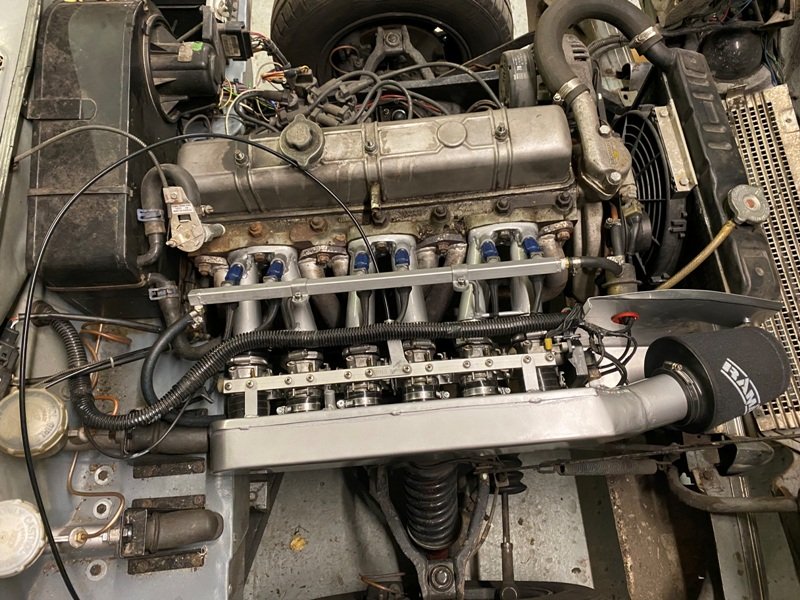-
Posts
1273 -
Joined
-
Last visited
-
Days Won
4
Everything posted by VitesseEFI
-

azzurros 1966 FIAT Duemilatrecento Familiare Discussione
VitesseEFI replied to azzurro's topic in Project Discussion
Nice. Not sure I’ve ever seen an estate/wagon version in the flesh. Fella across the road from us in Malawi (!) had a saloon version in an orangey colour. Sounded nice. He rescued it from a scrapyard and had trouble getting parts for it as quite possibly it was the only one in the country. This was in about 1976…. His neighbour had a Unimog 404 LWB. Also scrapyard rescue, dragged home by the Fiat - which had a new clutch soon after! -
Usually means they blow-up a lot, hence high demand….
-
Ah…. Challenges. Big challenges. Old fashioned pushrod V6s and V8s are amazingly compact. Modern DOHC multi-valve ones though are mostly very bulky at the top-end. Winged sumps are a PITA…..
-
You mentioned that you didn’t think you could use your existing flywheel because the teeth were “cut wrong” for starter on the opposite side? I assume you mean to allow the starter gear to go into engagement? Not sure this is a problem in reality. I run a modified Nippon Denso reduction gear starter on my old Triumph. As the car originally had an inertia starter, where the gear engages from the back, the gearbox side of the teeth are chamfered. The engine side are not. The ND starter does not care at all and engages cleanly 100% of the time.
-
This makes me sad. The extra performance that has been wrung out of this once ordinary small car, on a budget, by cunning raiding of the (used) Toyota parts bin, and then still more cunning, mixed in with 3D printing, carbon-fibre bothering and a whole heap of graphs and charts..... not to mention plenty of skinned knuckles and general back-breaking effort, is just startling. 9000 rpm......Surprising track performance, astonishing 1/4 mile times....... and yet, only one oil filter assembly put into low-earth orbit...... This is the project that tipped me into joining this forum, no regrets on that score. Even if I'm a bit confused by the local language at times
- 1536 replies
-
- 18
-

-

-

SEEN88's 2001 Renault Clio RS 172 - Frogsport
VitesseEFI replied to SEEN88's topic in Other Projects
For sure. -

SEEN88's 2001 Renault Clio RS 172 - Frogsport
VitesseEFI replied to SEEN88's topic in Other Projects
Nice. Getting hard to find in decent unmolested condition here in the UK. Factory suspension is hard to improve on. -

Tech Spam thread - because 1/4" BSP gets 5 hand spans to the jiggawatt
VitesseEFI replied to Roman's topic in Tech Talk
If it‘s windows 10…. They all do that sir. Microsoft seem to forget who’s computer it is. + 1 for the SSD drive. I did this to our main home laptop a couple of years back and improvement was just astonishing. I cloned the original HDD onto the SSD, so fresh install was not a factor. -
Likewise. Don’t need to be fake to be crap. I’m struggling with the idea that you can run the engine for two years with good oil pressure and the filter remains dry. I guess this engine must have an external bypass? All the engines I’ve ever worked on have relied on relief valves within the filter canister to bypass the element if it clogs. This means no oil in the filter =no bearings left. As the pop pressures on the internal relief valves are at least 1 Bar I assume your external valve must be at least that, so pretty amazing no oil has even reached the filter…. Most unexpected!
-

Sc@Chi's Clubman Estate discussion thread
VitesseEFI replied to Sc@ Chi's topic in Project Discussion
Looks like a typical Mini to me. They are distressingly water soluble. In the late 80s I remember dismantling a mk1 shell with my bare hands and a vacuum cleaner. At the end the only things holding the front and rear together was the roof and the tunnel. Luckily the owners sister had another Mini we could take measurements from….. Got built into a combined road/hillclimb car and is still around although had to be done again a few years ago. Good to see an estate getting saved. Not very many left. Edit: Meant to also say that although I’m not the greatest Mini enthusiast (!) they do at least have a pretty simple structure and most panels are available. Some of them are even approximately the right shape. Also great driving fun on a twisty road. Especially with a few extra horses. -
Saw this and thought of you….. possibly not relevant at this point but maybe one day
-
Don’t see a problem using the relevant sized roll-pins for the dowels…. Nick
-
This would be my bet…
-
Way ahead of me then(unsurprising!). Putting the electronics somewhere less hostile sounds like a good plan. If you just run it at full chat does it even need any electronics? (it's always a bloody capacitor.....)
-
Hah… same problem when you put a Herald 1300 sump on a Spit 1500 engine. Makes a very scary noise! Nice work on the sump mod. Look waaay better than the last effort
-
Pity you didn’t get to do some full sessions. You are good at finding the positives though Seems like a coolant temperature gauge would be a good thing to have. Shouldn’t be hard to arrange? When the pumps die, are they completely done? Cooked motor windings? Or is there some clever stuff in there too that gives up? Edit: found this Which answered some of my questions. Presumably as you have an aftermarket ECU your control methods are different?
-
Yep. Jimny box (pre-VVTi has overdrive fifth gear) will also accept the 1.5 and 1.6 versions of the M-series. Very light but not especially compact and available sump shapes less than ideal. Got some way along the road of sticking one in a Triumph Spitfire - possible but non-trivial. What we really wanted was a G13B on an SJ RWD gearbox (which is powerful, light and very compact) but G13B are now rare/big money here on the Septic Isle. Now working on getting a Ford Zetec SE (sigma) lump in the Spitfire on an MX5 gearbox. The Ford engine and Mazda box are now friends (there's some big work behind that little statement) and we just have to shoehorn the combo into the car. FWD cooling plumbing is really a PITA for RWD install. The iron block ford zetec engines fit on the old T9 boxes and are ever so much better that the horrible pinto boat anchor they came with.
-
Interesting to see all the various techniques employed. The blend of old tech and new tech..... as to the results..... I guess if I have to ask (and I do), I won't understand...... Someone should buy them a stretcher /shrinker..... Nick
-

justharrys 1965 pontiac bonneville discussion
VitesseEFI replied to JustHarry's topic in Project Discussion
Yeah…. Not familiar with this engine, but it certainly can be a thing that one bearing location gets most failures. On the Triumph 6 it’s no 5 big end, on the small Triumph 4-pots it’s no 3 big end. Not obvious (to me) why - guess it’s where the air goes. The line between fail and getting away with it is quite fine. Well caught anyway and good luck with measuring in parts hunt -
Thought that one of the reasons for EWPs was so that you could vary their speed accordingly to heat loading?
-

justharrys 1965 pontiac bonneville discussion
VitesseEFI replied to JustHarry's topic in Project Discussion
Not ideal but could be far worse. Would be worth measuring the crank properly (micrometer) as assuming it’s not gone oval the standard shells would likely be fine. Damage was probably caused by short-term oil starvation either due to the sludge or slow build of oil pressure after long time standing. -
This, more testing needed
-

Discuss here about Yoeddynz's little Imp project...
VitesseEFI replied to yoeddynz's topic in Project Discussion
Classy work as always. And lots of clever little tricks and tools to help the process. I’m taking notes. Plagiarism is the sincerest form of flattery Nick -
22.9 reported…… that’s heavy duty drinking.
-
Having the rad temperature sensor in the outgoing flow gives the rad load/cooling efficiency. This makes it easier to control the fans and maintain a steady engine temperature as it gives an earlier indication that the rad is loosing the battle Senarios: - low load, low speed in traffic, so little actual airflow. Top hose temp won’t go up until the whole system is heat soaked. -high load, high speed. Top hose temp may be quite high but you don’t the fans on as there’s plenty of natural airflow.

